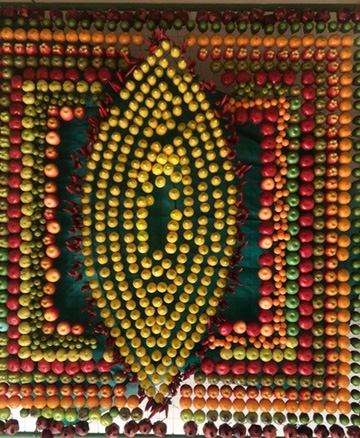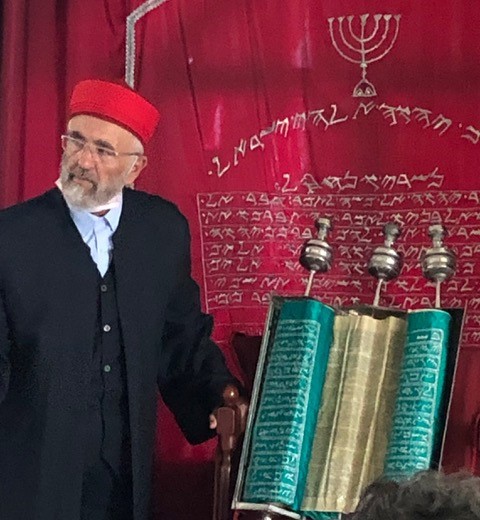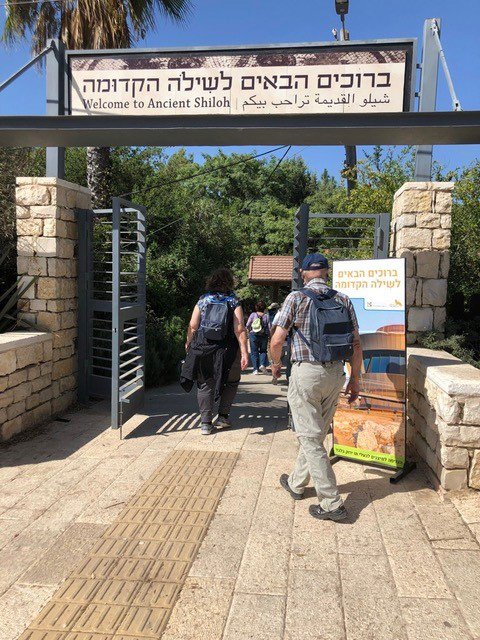Story and Photos by Steve Kramer
 KFAR SABA, Israel — With a number of fellow members of Hod Ve Hadar, the Masorti (Conservative in the US) synagogue that we belong to in Kfar Saba, we recently visited Mt. Gerizim, Har Bracha, and Shilo, all in the Biblical heartland of Samaria. Ordinarily, Michal and I don’t travel during Succos (pronounced Succot in Israel) because of the huge number of Israelis who tour throughout the country during the intermediate days of the holiday, making traffic unbearable.
KFAR SABA, Israel — With a number of fellow members of Hod Ve Hadar, the Masorti (Conservative in the US) synagogue that we belong to in Kfar Saba, we recently visited Mt. Gerizim, Har Bracha, and Shilo, all in the Biblical heartland of Samaria. Ordinarily, Michal and I don’t travel during Succos (pronounced Succot in Israel) because of the huge number of Israelis who tour throughout the country during the intermediate days of the holiday, making traffic unbearable.
We first made our way to the vicinity of ancient Shechem, originally a Canaanite city where the Tomb of Joseph is located. Shechem played a vital role in the history of Israel dating back to Abraham and Jacob. Its location in the middle of the Land of Israel was the most important crossroads in central Israel. The city lay along the northern end of The Path of the Patriarchs. This north-south route, on top of the Hebron, Judean, and Samarian mountain ridge, is the most logical route Abraham, Isaac and Jacob would have traveled between Beersheva, Hebron, Mt. Moriah (Jerusalem), Bet El, and Shechem. The Romans and subsequent conquerors used this existing road system and improved it. Today, the Path of the Patriarchs coincides with Rte 60, which runs from Beersheva to Nazareth.
The two large ridges of Mt Ebal (Curses) and Mt Gerizim (Blessings) would have been a barrier to invaders entering Canaan from the East. According to the Bible, the Israelites would have come that way into the promised land from across the River Jordan. On Mt Gerizim we saw the ruins of an Israelite altar. Evidence at the site dates it to about 3200 BCE, which most scholars estimate is the time when the Israelites entered the Land. This site is known today as Joshua’s altar, although that can’t be said with certitude.
Joseph’s Tomb is situated in the large Palestinian Arab city of Nablus, which is adjacent to the remains of Shechem. Visits to the tomb must be coordinated with the IDF because Nablus is under Palestinian Authority jurisdiction. We saw the tomb only while on the road to Har Bracha, (which means Mt of Blessings) a religious Israeli community located on Mount Gezerim. Har Bracha is mentioned in the Book of Deuteronomy: “When God your Lord brings you to the land which you are about to occupy, you must declare the blessing on Mount Gerizim…” (Deuteronomy 11:29). There are approximately 350 families currently living in the community.
The small community is essentially composed of young families in their twenties and early thirties, but there are also older families with married children who are raising the third generation there. The community started as an army outpost, and in 1982 it became a civilian community. After some false starts, in 1992 the Hesder Yeshiva of Har Bracha (a Torah academy combined with pre-army training) was established. Since its founding the community has grown each year and it boasts approximately 1,000 children between ages 0-18. Har Bracha is a Torah-based community. Rabbi Eliezer Melamed, and his wife, Rabbinit Inbal Melamed, are very involved in the life of the town. We were the recipients of their hospitality in the very large succah in the community after hearing both of them speak. (https://en.yhb.org.il/har-bracha/)


We visited the Samaritan village of Kiryat Luza on Mt Gerizim, the holiest site in the Samaritan religion. Best known from the Christian parable of the Good Samaritan, this community of just 800 people is split between Holon, a city just south of Tel Aviv, and the small village near Nablus. Not Jewish nor Muslim, with identities influenced by both, the Samaritans are Israel’s smallest religious minority. Those living in Kiryat Luza, a village under the control of the Palestinian Authority, are in many ways nationally and culturally Palestinian. They speak Arabic, study in Palestinian schools and universities and work in Palestinian government offices. Those who live in Holon are quite similar to Israeli Jews.
Palestinian Samaritans worship in a synagogue, speak ancient Hebrew and Arabic, observe the Sabbath, and celebrate Jewish holidays such as Passover and Sukkot (although the dates differ). Their holy text is called the Samaritan Torah. The Samaritans base their beliefs on the written Torah, rejecting the later Oral Torah and Mishna which are fundamental to rabbinical Judaism.
One of their better-known Samaritan customs is the sacrifice of animals on Passover – a tradition which Jews ended when the Holy Temple in Jerusalem was destroyed by the Romans in 70CE. Every Passover, the Samaritans gather on Mount Gerizim, sometimes with a crowd of up to 1000 curious international tourists and locals, Jewish and Palestinian, to carry out their ancient tradition of slaughtering sheep and grilling them over large, outdoor pits. Dressed in white robes, members of the faith slit the throats of dozens of sheep simultaneously, before dabbing the animals’ blood on the animal’s foreheads before grilling the meat.
The Samaritans are also famous for their incredible succahs built and displayed during Succot. These are not outdoor, flimsy booths like Jews build, but very heavy frames filled with beautiful fruits and hung indoors from the ceiling. The frames weigh hundreds of pounds and the fruits themselves obviously cost a fortune!
We received this information in the village’s Samaritan Museum, as explained by one of their most prominent priests, Yefet HaCohen. Worth mentioning is that many of us purchased the famous tehina (made primarily from sesame paste) from a shop on the way back to the bus.
Other facts about Samaritans are from this website: https://theculturetrip.com/middle-east/israel/articles/an-introduction-to-the-samaritans-israels-smallest-religious-minority/

Our last stop was Shilo, the first capital of the Israelites during the period when Joshua divided the Land of Israel among the 12 tribes by means of a lottery (15th c BCE). For 369 years, until Shilo’s sacking by the Caananites, the Tabernacle, which contained the Ark of the Covenant, was located in Shilo (according to the Book of Joshua). The Tabernacle (Mishkan) was the portable depository containing the Ark, which was carried through the desert and during the conquest of the Land of Israel, as described in the Book of Exodus.
Spiritually, the Ark was the manifestation of God’s physical presence on earth. It was used until the destruction of the First Temple, when it was lost to the Jews. The Ark was the most important symbol of the Jewish faith, the only physical manifestation of God on earth. (See addendum for the possible fate of the Ark.)
Shilo is located in the territory of the Tribe of Ephraim, which was the geographical center of the Israelites’ territory. Because the Tabernacle was there, Shilo was the place of pilgrimage for the Children of Israel. Three times during the year the faithful brought their festival offerings, on Passover, Shavuot, and Succot. Later, King David made Jerusalem the united capital of the Israelites, in the late 11th c BCE. (jewishvirtuallibrary.org)
Today, residents of Shilo and others come to the tel (tel: a mound of previous, destroyed communities built one atop another) for special events, such as bar and bat mitzvas, school plays, or weekly classes under the ancient trees. Not long ago Shilo was neglected and practically forgotten. But now Shilo is an official tour site and has become a popular tourist destination.
The modern town of Shilo is located near to Tel Shilo, the archeological site. The tel, which we visited, showcases the spiritual life of the Jewish people until its destruction, probably during the reign of King Saul (11th c BCE). The park was full of families, with many activities mostly geared to the many kids. There are artifacts from diverse periods, notably the end of the Second Temple (130 BCE – 70 CE), the Byzantine period (350 – 618 CE), and the early Muslim period (638 – 900 CE).
On the way to the highest point of the tel, we stopped in the remains of a Byzantine church for an excellent historical summary by our professorial guide. Further along, we had a beautiful view of the valley below. This is where the summer grape-harvest festival took place, when the daughters of Shilo danced in the fields before the men of the Tribe of Benjamin, who sought brides from among them, as described in the Book of Judges. This festival is recalled even today in Israel by Tu B’Av, Israel’s ancient version of Valentine’s Day.
Before leaving Shilo we watched an excellent documentary film about it, shown in a modernistic building at the top of the tel. Underneath the structure is a small but interesting museum, which Michal and I visited previously. The audio visual exhibits there are up-to-date and include a virtual reality tour of the Mishkan, whose site is currently being excavated. It is quite exciting to virtually enter the ancient abode of the Ark, “walking” among the artists’ interpretations of the Biblical descriptions. (For those travelers who only visit Jerusalem, there is a virtual reality tour of the Holy Temple on the Temple Mount at the fabulous Hebrew Music Museum in the center of town.)
In the tel itself we stood near the place where some scholars believe the Tabernacle was placed. During the film we had heard the story of Hannah, who was childless. When she came to pray for a son in front of the Tabernacle, Eli, the High Priest, saw her praying silently and mistook her for a drunkard. When Hannah explained herself, Eli assured her that she would indeed bear a son, which she did. Hannah dedicated her promised son, Samuel, to serve in the Tabernacle. Samuel the Prophet later anointed Saul, albeit reluctantly, to be the first King of Israel.
We had made good time during our travels but, inevitably, were caught up in holiday traffic for the ride back to Kfar Saba. Nevertheless, we enjoyed a very informative day trip during one of the best times to visit Israel. Now that traveling is becoming (slightly) less onerous, think of coming to Israel, a place which has so much to offer in so many categories.
Addendum
“When did the Ark of the Covenant disappear? The last historical mention of the Ark in Scripture is in Second Chronicles chapter 35, where King Josiah (who reigned in Judah c. 640-609 BCE) asked the Levites to return the Ark to the Temple where Solomon had originally housed it after completing and dedicating the Temple sometime in the 10th century BC (Second Chronicles, chapter 5). There is no mention as to why the Levites had removed the Ark in the first place, nor is there any indication as to whether or not the Levites acquiesced to King Josiah’s request.” https://www.allaboutarchaeology.org/when-did-the-ark-of-the-covenant-disappear-faq.htm
*
Steve Kramer is a freelance writer based in Kfar Saba, Israel. he may be contacted via steve.kramer@sdjewishworld.com